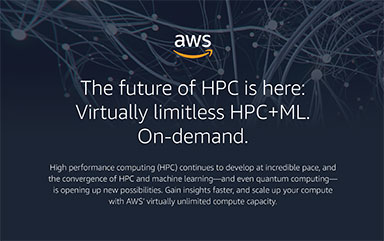Latest News
June 1, 2019
You’re working away, putting the final touches on your latest design iteration. You’re happy with it, but need to determine whether it will withstand an important load or use case—simulation to the rescue! Only one problem: You can’t get time on the company’s high-performance computing (HPC) cluster until next week. Your deadline, of course, is tomorrow. What to do?

What we think of as “the cloud” is a combination of CPUs, GPUs, storage and connectivity. If it’s inside your company’s firewall, it may be your company’s HPC center. If it’s outside, you rent time and/or space on someone else’s. The flexibility of the cloud means that you can rent whatever you need: compute cycles on a CPU or graphics processing unit, storage or a combination of both. And you can usually rent cloud capacity in flexible and creative ways: one CPU until your simulation is done (maybe in a day) or 24 CPUs until your job is done (say, an hour). Or 100 CPUs to get it that much faster.
External commercial clouds usually live in data centers that are maintained by Amazon, Microsoft or another third party that bring all of their security, fine-tuning, maintenance and similar expertise to your simulation. They host the simulation, pre- and post-processing software on their machines and you interact via a browser, uploading the setup and downloading the results.
The cloud can deliver HPC capabilities that expand as needed, and you pay only when you’re using them.
If this is so great, what are the downsides?
The Cons of Cloud Computing
The first and most-oft cited concern is security. Can someone hack into the model, the results or some other aspect that would give them access to critical intellectual property? Although we should never say never, and vendors have a vested interest in letting us all think things are OK, I have not heard of even one instance of IP theft in a cloud simulation case. We bank online and transmit other sensitive data via “the cloud,” so why not simulations? Trust in remote simulation will grow, even among the most conservative end-user industries.
But data security is not the only issue slowing adoption. We don’t typically need cloud capacity to run small simulations; we can do those on our desktops. We need help with complex, detailed and precise simulations, which typically take longer to upload and result in large output files, which then take a long time to download. Although it may solve quickly, the upload and downloads can slow us down. To get around this, many teams leave the data in the cloud, manage it there and download a subset of the post-processed results.
Lastly, and perhaps most importantly, is the simulation software itself available in the cloud? Whose cloud? Vendors have sold software on a per-CPU basis for many years. Asking them to make a license available to run a job that would take 100 hours on a single CPU is one concern; asking them for 100 licenses to run that same job in 1 hour—in a mechanism that doesn’t require 100x the cost—is another issue altogether. They’ve come up with many ways to address this problem, from pools of credits to pay-by-the-hour models and more (see page 24). Check with your vendor to see if they can accommodate your needs. You may want to consider a third party that provides cloud access to many CAE software packages.
A Virtuous Spiral
The bottom line? We seem to be in a virtuous spiral, where software keeps getting more capable and compute capacity grows cheaper and more available. This enables us to simulate more complex physics and systems, which require more capable software and hardware and so on. Using a flexible cloud lets us match capability to the needs of the user. Need a lot for a complex multiphysics simulation? You got it! Checking on a single component? Got that covered too, and for less than the cost of the first one. This elasticity will enable more people to do more simulations at the level of complexity they need, paying only for what they consume.
Subscribe to our FREE magazine, FREE email newsletters or both!
Latest News
About the Author
Monica Schnitger is the founder, president and principal analyst of Schnitger Corporation. She has developed industry forecasts, market models and market statistics for the CAD/CAM,CAE, PLM, GIS, infrastructure and architectural / engineering / construction and plant design software markets since 1999.
Follow DE





